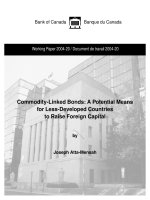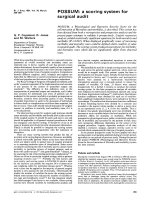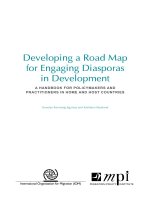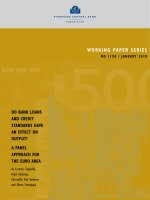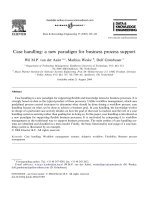the extracted mba a topical reference for the contemporary mba
Bạn đang xem bản rút gọn của tài liệu. Xem và tải ngay bản đầy đủ của tài liệu tại đây (2.71 MB, 248 trang )
The Extracted MBA
extractedmba.com
The Extracted MBA
The extracted mba
•
A topical reference for the contemporary MBA
Kelly Vinal
FIRST EDITION
Universal Publishers
Parkland, Florida
Upublish.com
Kelly Allen Vinal
Copyright 2000 by Kelly Allen Vinal
All rights reserved. No part of this book may be reproduced in any form
or by any means, electronic, or mechanical, including photocopying,
recording, or by any information storage or retrieval system, without
written permission from the author. Inquiries should be made to
Vinal, Kelly Allen.
1967-
The Extracted MBA : A topical reference for the contemporary
MBA / by Kelly Allen Vinal
ISBN 1-58112-735-9
Printed in the United States of America
First Edition
1 2 3 4 5 6 7 8 9 10
The Extracted MBA
EXTRACTED ACKNOWLEDGEMENTS
To my fellow MBAs out there who tirelessly manage the industries and
organizations that have made the American economy the most powerful in
the history of the world.
To the professors, staff, students, and alumni of the University of
Phoenix. An innovator in the field of continuing education, the success
of UOP graduates is proof that the UOP's high standards and programs
make their cutting-edge educational philosophy a template for others to
follow.
Finally, to my peers, subordinates, and superior officers of the United
States Army. The greatest asset of any organization is its people. Those
who serve in the defense of our way of life are the clearly best that
America has to offer.
MAINTAIN!
Questions, comments, or suggestions? Visit the companion site to this
book at www.extractedmba.com, or e-mail the author at
All inquiries will receive a response by the
author, and all accepted suggestions will be acknowledged in future
editions.
Cover by Matt Sorenson
Kelly Allen Vinal
For Henry G. Vinal
My Extracted Father
The Extracted MBA
EXTRACTED CONTENTS
Extracted Introduction vii
Extracted Management 1
Extracted Human Resources Management 20
Extracted International Business and Global Competition 39
Extracted Organizational Behavior 56
Extracted Marketing 72
Extracted Strategic Management 95
Extracted Business Law 107
Extracted Information Management 151
Extracted Electronic Commerce 167
Extracted Accounting 177
Extracted Statistics 198
Extracted Economics 211
Extracts About the Author 236
Extracted Bibliography 237
Kelly Allen Vinal
EXTRACTED INTRODUCTION
The Extracted MBA represents the culmination of a decade's worth of
undergraduate and graduate study, as well my practical management
experiences, both in my work and in the courses I teach. Upon being
awarded my MBA in 1998, I searched for a book that could concisely
provide a reference, a recap if you will, of what I had learned in my years
of study. Sure, there were books out there that professed to make MBAs
out of lay folk, but they were the literary equivalent of snake oil. There
simply wasn't a book written for MBAs that provided what I desired, and
what I truly believed that the MBA community needed. I sat at my
computer one night and began transcribing the four boxes of notes I had
accumulated in the course of my studies. It would be three weeks before I
completed the first section of the first management course I had ever
taken. Aptly, that was Extracted Management! I read through it and
realized that I had an opportunity to create a reference that myself and my
fellow MBAs could really use! The Extracted MBA was born. I hope
these series of extractions serve you well as you recount the topics that
whizzed-by in the torrent of information to which we were exposed. With
this tool, may your MBA skills remain as fresh as the day you walked
across the stage and received your degree!
Please note that the extracts are organized in a quasi-outline format, with
indentations that expound on preceding notes.
Kelly A. Vinal, MBA
May 15th, 2000
Fayetteville, North Carolina
Extracted MANAGEMENT
www.extractedmba.com/mgt.html
The Extracted MBA
2
Defined
Planning, organizing, leading and, controlling resources for the purpose
of achieving organizational goals.
Management functions
• Conceived by Henri Fayol in 1917.
Planning: Defining the goals as directed by executive management;
developing strategy; conceptualizing coordinated efforts.
Organizing: Establishing the tasks that will achieve the goals;
defining lines of leadership; determining where decisions will be made.
Leading: Motivating and directing subordinates; establishing
effective communications; resolving conflicts quickly and equitably.
Controlling: Ensuring tasks are accomplished as planned and
correcting deviations.
The optimized organization
Organization: A collective social unit that is goal oriented and
formally structured.
Performance: An organization’s actions that measurably contribute to
the achievement of organizational goals.
Efficiency: The achievement of organizational goals with the minimal
consumption of resources.
Effectiveness: The extent to which an organization achieves
established goals.
Management skills
Technical Skills: The ability to apply specialized expertise.
Human Skills: The ability to work with and motivate individuals or
groups of individuals.
Kelly Allen Vinal
3
Conceptual Skills: The ability to mentally analyze abstract and/or
complex challenges.
Core concepts
Organization: A coordinated group of individuals that functions on a
continuing basis for the purpose of achieving one or more goals.
Executives: Individuals who set organizational goals and policies.
Managers: Individuals in an organization who achieve goals through
subordinates. Commonly referred to as administrators in non-profit
organizations.
Supervisors: People who provide direct leadership over line
employees for the purpose of achieving management’s goals.
Supervisors are typically individuals with expertise in all of the tasks of
their subordinates, and are generally promoted from the ranks of the
employees they oversee.
Workers: Individuals employed to accomplish specific tasks for the
purpose of achieving the organizational goals set by executive
management.
Management roles
• Conceived by Henry Mintzberg in 1973.
• Also known as Mintzberg’s Managerial Roles.
Interpersonal Roles
Figurehead: Symbolic chief; performs routine ceremonial functions
and solicitations.
Leader: Directs and motivates subordinates.
Liaison: Maintains internal and external contacts of individuals and
groups that are of benefit to the functioning of the organization.
Informational Roles
The Extracted MBA
4
Monitor: Serves as central figure in obtaining and categorizing
internal and external information relating to the organization.
Disseminator: Communicates information obtained from outside
sources, as well as from subordinates, to appropriate members of the
organization.
Spokesperson: Transmits information relating to the organization to
external entities; is an expert in virtually all aspects of the organization, as
well as its respective industry.
Decisional Roles
Entrepreneur: Scours the organization in search of opportunities to
bring about positive, if not profitable results.
Disturbance Handler: Implements corrective action to counter
important and unexpected turmoil within the organization.
Resource Allocator: Makes or approves important decisions, and
ensures they are adequately staffed and funded.
Negotiator: Represents the organization in negotiations.
Activities of successful managers
• Conceived by Fred Luthans in 1988.
Luthans determined that a study of 450 managers showed that the
successful ones all engaged in the following activities:
Traditional Management: Decision-making, planning, and
controlling.
Communication: Exchanging information and processing
paperwork.
Human Resource Management: Motivating, disciplining, staffing,
training, and resolving conflict.
Networking: Socializing, politicking, and interacting with outsiders.
Kelly Allen Vinal
5
The learning organization: An organization in which problem solving is
encouraged at all levels that results in increased operational capability.
Interwoven characteristics:
• Conceived by Peter Senge in 1990.
• Leadership
• Empowered employees
• Shared information
• Horizontal structure
• Emergent strategy
• Strong culture
Paradigm: A widespread and ingrained conceptualization of the
operational environment.
Paradigm shift: A change in environmental circumstances that
leads to an altered understanding of the world.
Evolution of the learning organization
Classical perspective: Management philosophies that emerged in the
late 19
th
and early 20
th
century, embracing scientific and rational
approaches to forging efficient and productive organizations.
Scientific management: Management perspective that relied upon
early research and emphasized scientifically demonstrated measures to
change management and increase productivity.
• Conceived by Frederick Taylor in 1898.
• Significantly refined by Lillian and Frank Gilbreth in the early 1900s.
Bureaucratic organizations: Concept that touts impersonal and
rational management that is characterized by clearly defined authority,
meticulous record keeping, and separation of management and
shareholders.
• Conceived by Max Weber in 1927.
Administrative principles: Focused on the organization as a whole
by delineating planning, organizing, coordinating, and controlling.
The Extracted MBA
6
• Conceived by Henri Fayol in 1930.
Humanistic perspective: Management philosophies that emerged
concurrently with the classical perspective that focused upon employee
needs, behavior, and attitudes.
The human relations movement: Sparked by the Hawthorne studies
in 1924 and involved management in focusing upon the basic needs of
employees as the primary factor in increased productivity.
The human resources perspective: Philosophy that embraces
designing jobs that challenge employees to maximize their potential.
Maslow’s Hierarchy of Needs: A hierarchy of five needs that
represent human drive, based on the premise that once a need is met, the
next higher need becomes dominant.
• Conceived by Abraham Maslow in 1954.
1. Physiological: Includes hunger, thirst, and shelter.
2. Safety: Includes security and defense from physical and
emotional harm.
3. Social: Includes affection, acceptance, friendship, and
belonging.
4. Esteem: Includes self-respect, autonomy, achievement,
status, recognition, and attention.
5. Self-actualization: Is reached when an individual
become what he or she or she is capable of.
Theory X and Theory Y
• Conceived by Douglas McGregor in 1960.
Theory X: Is the assumption that employees are inherently
lazy, abhor work, and must be coerced into performing.
Theory Y: Is the assumption that employees enjoy working,
desire responsibility, and can work without direction.
The management environment: All factors that exist within and beyond
an organization’s boundaries that can affect the organization.
Kelly Allen Vinal
7
Internal environment: The environment within an organization’s locus
of control.
• Employees
• Management
• Organizational culture
General environment: The environmental layer that indirectly
influences the organization’s operations
• Technological
• Sociocultural
• Economic
• Legal
• Political
• International
Task environment: The external layer of the management environment
that directly affects the organization.
• Customers
• Labor market
• Suppliers
• Competitors
Ethics in management
Ethics: Code of moral values that govern the fundamental behaviors of
individuals, groups, and organizations.
Ethical dilemma: A condition that arises when a decision must be
made, and the alternatives are ethically undesirable, causing difficulty in
determining right from wrong.
Utilitarian approach: The ethical principle that morally positive
actions invariably result in overall good.
Moral-rights approach: States that moral decisions are best made by
those affected by them.
The Extracted MBA
8
Individualism approach: The concept that acts are moral when they
serve in the best interest of the individual’s long-term interests.
Justice approach: The concept that moral acts must be based on
equity and impartiality.
Distributive justice: States that people should be treated according
the differences between them.
Procedural justice: All ethics should be derived from clearly defined
rules that are consistently applied.
Entrepreneurship: The process of engaging in business ventures that
require acquiring and organizing resources, assuming risks, and reaping
rewards.
Entrepreneur: An individual who recognizes a business opportunity
and acts to capitalize upon it.
Intrapreneur: An individual who seeks and acts upon opportunities
within an organization.
Organizational planning
Goal: A future state an organization desires to achieve.
Plan: A design of the actions, resources, and personnel that will
achieve a goal.
Planning: Determining actions that will achieve an organization’s
goals.
Organizational goalsetting
Mission: An organization’s purpose.
Mission statement: A broadly stated expression of an organization’s
unique business scope and operations.
Strategic goals: Broad statement of the desired future position of an
organization as a whole.
Kelly Allen Vinal
9
Strategic plans: Actions an organization intends to take to achieve its
strategic goals.
Tactical goals: Goals set for major departments in an organization
designed to achieve strategic objectives.
Tactical plans: Actions that major departments must accomplish to
achieve tactical goals.
Operational goals: Specific results expected from departments,
groups, and individuals within an organization.
Operational plans: Specific actions developed to support tactical
goals.
Management by Objectives: A system by which specific goals are set
by the entire workgroup, a timeline is established, and feedback on
progress is ongoing.
• Also known as MBO.
• Conceived by Peter Drucker in 1954.
Shewhart cycle: Quality management planning cycle used for
organizational improvement that includes:
• Plan: Determine desirable changes and prepare for
implementation.
• Do: Execute the changes.
• Check: Observe the result of the changes.
• Act: Perform analysis of the changes and implement broadly.
Single-use plans: Plans developed for goals that will only be set once.
Standing plans: Plans developed for guiding tasks that are performed
repeatedly.
Contingency plans: Plans that spell-out an organization’s response to
specific, pre-determined events.
The Extracted MBA
10
Strategic management: Actions and guidance that serve to formulate
organization-level strategy for the purpose of achieving competitive
success.
Strategy: Plan of action that details resource allocation, labor,
marketing, and capitalization required to achieve organizational goals.
Core competence: A business aspect upon which an organization
identifies itself.
Synergy: Occurs when the elements of an organization produce an
outcome that is greater than all of the elements acting independently.
Situation analysis: The evaluation of strengths, weaknesses,
opportunities, and threats affecting the organization.
• Also known as SWOT analysis.
Differentiation: Competitive strategy whereby an organization
strives to distinguish its products from its competitors’.
Cost leadership: Cost-control strategy an organization undertakes to
maximize efficiency and minimize costs to increase competitiveness.
Focus: Competitive strategy that is characterized by concentration on
a particular group of potential customers.
Product life cycle: The stages a product endures, from development
and introduction, through maturity and growth, and finally to decline.
Decision-making and problem solving
Decision: A choice made from various alternatives.
Decision-making: The process of identifying problems and plausible
solutions.
Programmed decision: A decision made as a result of a situation that
occurs on a regular basis.
Nonprogrammed decision: A decision made as a result of a unique
situation.
Kelly Allen Vinal
11
Risk: The possibility that a decision may prove to be the wrong one,
as well as the possibility that the potential gain plus additional resources
may be lost as a result.
Certainty: The level of confidence the decision-maker has in the
information available to him or her.
Uncertainty: The level of confidence a decision-maker lacks as a result
of incomplete or suspected inaccurate information.
Ambiguity: The goals or problems are unclear, with uncertain
alternatives, and incomplete information.
Classical model: A decision-making model that assumes that
managers make decisions in the best interests of their organizations.
Normative: The approach that shows how a manager should make
decisions, with guidelines for reaching solutions in the best interest of the
organization.
Administrative model: A decision-making model in which managers
make decisions in situations involving ambiguity and uncertainty.
Bounded rationality: States that individuals are limited in their
decision-making abilities due to their cognitive capacity to process only a
certain amount of information.
Intuition: An understanding of a decision situation based
unconsciously on past experience.
Organizational structure
Organizing: Employing resources for the purpose of attaining
organizational goals.
Organization life-cycle: An organization’s progress from inception
through decline.
Birth stage: The creation of the organization.
Youth stage: Characterized by rapid growth and market success.
The Extracted MBA
12
Midlife stage: Characterized by substantial size and prosperity.
Maturity stage: The decline of the organization due to inefficiency,
excessive size, and an overly mechanistic structure.
Structure: Framework whereby an organization clearly defines roles,
leadership, resource allocation, task division, and departmental
coordination.
Organization chart: The visual depiction of an organization’s
structure.
Division of labor: The subdivision of labor into specialized tasks
and individual jobs.
• Also known as work specialization.
Authority: The legitimate power accorded managers to make
decisions, allocate resources, and otherwise act within his or her
authorized purview.
Chain of command: An unbroken supervisory link that connects all
employees within an organization, from the line worker to the CEO.
Accountability: The requirement for those subject to authority to
justify outcomes to superiors.
Responsibility: The implicit duty of an employee to perform an
assigned task.
Delegation: The transfer of authority from a manager to a
subordinate.
Span of management: The number of employees reporting to a
manager.
• Also known as span of control.
Centralization: Decision authority is concentrated at the top of the
organizational hierarchy.
Kelly Allen Vinal
13
Decentralization: Upper management pushes decision-making
authority to lower organizational levels.
Tall structure: Characterized by a large number of hierarchical
levels and a relatively narrow span of management.
Flat structure: Characterized by few hierarchical levels and a broad
span of management.
Organizational change: The adoption and implementation of
innovations and new behaviors by an organization.
Reactive change: Changes that occur after external forces have
affected organizational performance.
Proactive change: Changes initiated in anticipation of future events
and opportunities.
Sequence of organizational change
• Environmental and internal forces → Need for change → Initiate
change → Implement change
Performance gap: The gulf between desired and actual performance.
Initiating change
Search: Discovering developments internally and externally that
can satisfy a need for change.
Creativity: The creation of innovative solutions for organizational
problems.
Idea champion: An employee who determines a need exists within
an organization and actively strives to satisfy it.
New venture team: A temporary task force assigned to solving
organizational problems and developing innovations.
New venture fund: A fund established to provide resources for
individual and group-developed innovations.
The Extracted MBA
14
Implementing change
Force field analysis: Determining which forces drive or resist
proposed changes.
Communication and education: Providing employees with detailed
information on impending organizational changes through presentations
and info papers.
Participation: Involves employees with the organizational change
process.
Negotiation: A formal bargaining process between management and
subordinate business units and employees that serves to set changes in
terms that are mutually acceptable.
Coercion: The use of formal managerial power to force changes
upon an organization.
Top management support: The public expressions by executive
management in support of organizational changes.
Categories of organizational change
Technology changes: A change that incorporates developing
technology that improves communication, management, and production.
Product changes: A significant change in a company’s product or
service.
Structural changes: Any adjustment of an organization’s
management or functional structure.
Cultural changes: A change in employee beliefs, values, and
norms.
Leadership: An individual’s ability to influence a person or group of
people to perform functions that reach goals.
Trait theories: Theories that promote individual personality traits
as factors that determine leadership effectiveness.
Kelly Allen Vinal
15
Behavior theories: Theories that promote behaviors as factors in
determining leadership effectiveness.
Ohio State Studies
• Conceived by R. M. Stogdill and A. E. Coons in 1951.
Initiating structure: The structuring by a manager of roles to
best achieve goals.
Consideration: The propensity of a manager to form professional
relationships based on trust, respect, and regard for subordinates’
feelings.
University of Michigan Studies
• Conceived by R. Kahn and D. Katz in 1960.
Employee-oriented leader: A leader who promotes interpersonal
relationships.
Production-oriented leader: A leader who promotes task-
orientation.
The Managerial Grid: A matrix that graphically illustrates
leadership styles by identifying 81 different leadership styles.
• Conceived by R. R. Blake and J. S. Mouton in 1964.
Scandinavian Studies
• Conceived by G. Ekvall and J. Arvonen in 1976.
Development-oriented leader: A leader who is willing to take
risks, experiments, and develops new ideas to accomplish goals.
Contingency Theories of Leadership
Fiedler contingency model: States that effective groups require a
match between a leader’s style and his or her subordinates’ personalities.
• Conceived by F. E. Fiedler in 1967.
The Extracted MBA
16
Cognitive resource theory: States that by first making plans,
decisions, and strategy, a leader’s effectiveness is enhanced.
• Conceived by F. E. Fiedler and J. E. Garcia in 1987.
Hersey and Blanchard’s Situational Theory: States that leadership
effectiveness is greatly influenced by subordinates’ readiness.
• Conceived by P. Hershey and K. H. Blanchard in 1974.
• Telling (high task – low relationship)
• Selling (high task – low relationship)
• Participating (low task – high relationship)
• Delegating (low task – low relationship)
R1: People are both unwilling and unable accomplish a task.
R2: People are unable but willing to accomplish a task.
R3: People are able but unwilling to accomplish a task.
R4: People are both able and willing to accomplish a task.
Leader-Member Exchange Theory: States that leaders form “in”
and “out” groups and that individuals in the “in” groups will perform
better than those who are not.
• Conceived by F. Dansereau, J. Cashman, and S. G. Green in
1973.
Path-goal theory: States that subordinates accept a leader’s
behavior, as they view it, as a source of satisfaction.
Attribution theory of management: Postulates that leadership is an
attribution made by individuals of others.
Charismatic leadership theory: A subcomponent of attribution
theory that states followers attribute heroism or extraordinary leadership
skills based on observing certain behaviors.
Characteristics of charismatic leaders:
• Self-confidence
• Ability to articulate vision
Kelly Allen Vinal
17
• Strong convictions about the vision
• Extraordinary behavior
• Perception as an agent of change
• Environment savvy
Transactional leaders: Those who are goal-oriented and motivate by
clarification of roles and tasks.
Transformational leaders: Achieve by providing individualized
direction, intellectual stimulation, and demonstrating charisma.
Power: The ability of an individual to influence behavior in others to
perform functions they would otherwise not perform.
Dependency: The relationship between two entities where one
possesses something the other requires.
Basis of power
Coercive power: Based on fear.
Reward power: Based on the ability to provide rewards for desired
behavior.
Legitimate power: Based on the position one holds as bestowed by
an organization.
Expert power: Based on specialized skills or abilities.
Referent power: Based on the possession of resources or traits.
Elasticity of power: The impact of power in variable alternatives.
Power tactics: Means by which individuals exercise their power into
action.
• Reason
• Friendliness
• Coalition
• Bargaining
• Assertiveness
• Higher authority
